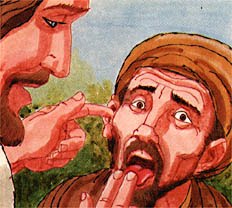True eternal life begins with a personal relationship and journey with Jesus Christ (Rom 6:23). A man or a woman created in God’s image for abundant life has a choice to make between the wages of sin, eternal death, and the gift of God, eternal life (Gen 2-3). The Gospel of John gives us a definition of Christ’s gift of eternal life: “And this is life eternal, that they might know thee the only true God, and Jesus Christ, whom thou hast sent” (Jn 17:3). Sin is a barrier to eternal life hence, the need to accept Jesus’ forgiveness for sin by yielding our lives to Him. The greater truth at the heart of the Gospel is about repentance and salvation. Repentance starts with the acknowledgement that all is not well without Jesus. The parable of the Good Samaritan is not just a journey story: “A certain man was going down from Jerusalem to Jericho” (Luke 10:30). The parable is a journey in which someone is asking for direction, a map to eternal life: “What must I do to inherit eternal life?” In our rugged individualistic culture, there is more to eternal life than many secularised and nominal Christendom expressions bearing in mind the serial advance of Christianity.
Jesus Christ, the Good Samaritan as the missional map to eternal life calls for a fundamental shift in what we ‘do’ to a humble acceptance of God’s gift of salvation ONLY in Jesus Christ. A map in this context serves as a metaphor to guide the church beyond its present unhealthy symptoms, disorientation, and decline. In our rugged individualistic culture, to be modern is to throw off the claims of the Scripture and history in order to fashion our own identities and gender, free and fully ‘ourselves.’ Alan Roxburgh in one of his books, Missional Map-Making: Skills for Leading in Time of Transition ‘depicts a widespread sense of disorientation besetting church leaders in our time.’ The failure of the map of modernity[1] with its divisions shaped and marked by loss of faith and belief in the intervention of divine forces calls for the most crucial question in the world for mortal men and women; “What must I do to inherit eternal life?”
The parable of the Good Samaritan provides the direction to true faith and obedience, the kind of direction that leads to spiritual salvation shaped by a genuine relationship with Jesus Christ which is the foundation of true love, an active compassion for our neighbour. Jesus never answer the question, “Who is my neighbour?” Jesus basically told the lawyer as He is telling many today to reach out and be a Christian neighbour, that is, “Go, and do thou likewise” (v37). Jesus’ answer makes many uncomfortable even today. Just as Queen Victoria wanted to be sure in this life of eternal safety, John Townsend’s response to the Queen’s question is a warning to the ‘doubting Thomases’ to believe in the finished work of Jesus Christ for them and prepare for that home of which Jesus said, “I go to prepare a place for you.”
The lawyer’s encounter with Jesus in the parable points us to the map and future of Christian theology, foundation of true Christian leadership and theological scholarship. The decision to accept Jesus Christ allows us to begin experiencing the benefits of eternal life as we continue to grow in a relationship with Jesus and others. Experiencing eternal life right now requires an active, ongoing faith and a deepening relationship with Jesus Christ (1Jn 5:12). There is no eternal life apart from a relationship with Jesus Christ (Jn 10:27). Experiencing eternal life also as a future hope of living forever with God ‘is associated with either passing from this life through physical death or going with Christ when He returns for His faithful followers (Jn 14:3, Mk 10:30). Our true discipleship, leadership, debate, and stewardship depends on our humble person encounter with Jesus.[2] The ONLY one who can provide salvation is the Good Samaritan, Jesus Christ, since Samaritan means “guardian.” Jesus is the ONLY one for binding of our wounds, that is, the restraint of sin, and oil the comfort of our hope in eternal life. To imitate Jesus, the Good Samaritan, first we need his encounter and healing.
Journey from Jerusalem to Jericho symbolises “going down” in decline, death, and leaving a semi-dry area for a totally barren and parched one. It is important to identify which of these characters on the journey from Jerusalem to Jericho we resemble individually and corporately. Using the words of St Augustine’s map of the parable, taken from his Questions on the Gospel’s, ‘The traveller is Adam, that is, humanity—you and I. Jerusalem represents the heavenly city. Jericho, because of its etymological relation to the Canaanite word for “moon” (Yareaẖ), represents the waxing and waning of our mortality. The thieves represent Satan and the fallen angels, who strip Adam of his clothing—that is, they deprive him of his immortality—and beat him by persuading him to sin. This leaves the man “half dead”—only half dead, that is, because although he is “wasted and oppressed by sin,” he is not rendered completely incapable of knowing God. The priest and the Levite represent the Old Testament and its ritual dispensation, which could not provide salvation.’ Satan and his fallen angels continue to weaken and oppress the family, church, and nations through sin thereby leading to the present global dangerous journey and death – spiritually, martially, politically, and economically. We remain illiterate doomed for destruction in the journey from Jerusalem to Jericho without the intervention of the Good Samaritan, Jesus Christ.
Signs of unhealthy family, churches, and nations abounds, seeking pleasure, freedom and prosperity but turning our backs on sin and repentance. In one of Pope Francis’s encyclical, Fratelli Tutt, the parable of the Good Samaritan illustrates symptoms of an unhealthy church in an unhealthy, divided and broken society.[3] We are in world of information without wisdom, a church full of information without transformation. True wisdom from God demands an encounter with Jesus Christ. In a world that everything can be recreated, disguised, redefined, and altered, the parable provide a map, a direction and decision we need to make in order to rebuild our broken homes, divided churches and wounded world. Each day we have to decide to follow the map in the footstep of Jesus, the Good Samaritans or indifferent bystanders. Failure to follow the map for eternal life in the footstep of Jesus Christ ‘would make us either one of the robbers or one of those who walked by without showing compassion for the sufferings of the man on the roadside.’ The parable of a Good Samaritan as a map to eternal life, a life of acquaintance with God in Christ offers us a new opportunity with new possibility.
Beyond our ‘Glass Cage’ of love, only in the footstep of Jesus Christ, the Good Samaritan could the genuine love, the neighbourhood, we owe to everyone be found. The description of the difference between a paper map and a GPS by Nicholas Carr in his book, How Our Computers Are Changing Us: In the Glass Cage, warns us about a different relationship with the world that can leave us disengaged and discontented. According to Carr, GPS are “not designed to deepen our involvement with our surroundings. They’re designed to relieve us of the need for such involvement.” Human love can relieve you a particular need but cannot grant you eternal life. Jesus, the Good Samaritan as the missional map to eternal life direct us in our journey to eternal life through His Word, the Bible, a sacred text for personal and corporate transformation. Beyond the use of paper-map for stronger memories, Jesus Christ, the Good Samaritan provides practical wisdom and the ability to discern God’s will in our daily walk; our eyes are opened to the way of God as the psalmist said: “Your Word is the lamp on my footstool and the light in my path.” In the footstep of Jesus, the Good Samaritan, we are called to renounce taking the place of moral superiority that dispenses or withholds charity as pleases. Remember, eternal life begins with faith in Jesus Christ. Jesus is the way to eternal life, all you have to do is to confess and follow Him as your Lord and Saviour.
[1] Roxburgh, Alan, Missional Map-Making: Skills for Leading in Times of Transition (San Francisco, CA: Jossey-Bass, 2010), pp. xi, 79
[2] Walls, Andrew, “Culture and Coherence in Christian History,” in The Missionary Movement in Christian History: Studies in the Transmission of Faith (Maryknoll, N.Y: Orbis Books, 1996), pp. 22-25
[3] https://www.vatican.va/content/francesco/en/encyclicals/documents/papa-francesco_20201003_enciclica-fratelli-tutti.html











Recent Comments